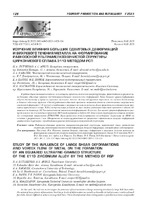| dc.contributor.author | Лутченко, Н. А. | ru |
| dc.contributor.author | Арбуз, А. С. | ru |
| dc.contributor.author | Кавалек, А. А. | ru |
| dc.contributor.author | Панин, Е. А. | ru |
| dc.contributor.author | Попов, Ф. Е. | ru |
| dc.contributor.author | Магжанов, М. К. | ru |
| dc.coverage.spatial | Минск | ru |
| dc.date.accessioned | 2023-03-27T13:25:32Z | |
| dc.date.available | 2023-03-27T13:25:32Z | |
| dc.date.issued | 2023 | |
| dc.identifier.citation | Изучение влияния больших сдвиговых деформаций и вихревого течения металла на формирование равноосной ультрамелкозернистой структуры циркониевого сплава Э110 методом РСП = Study of the influence of large shear deformations and vortex flow of metal on the formation of an equiaxed ultrafine-grained structure of the E110 zirconium alloy by the method of RSP / Н. А. Лутченко [и др.] // Литье и металлургия. – 2023. – № 1. – С. 128-134. | ru |
| dc.identifier.uri | https://rep.bntu.by/handle/data/126908 | |
| dc.description.abstract | В работе была поставлена задача – исследовать процессы изменения микроструктуры, происходящие в сравнительно больших объемных прутках под действием больших пластических деформаций. Такие большие уровни деформации обычно достижимы в процессе кручения маленьких плоских дисков под высоким давлением, но сложно достижимы в больших объемных прутках. Способ радиально-сдвиговой прокатки позволяет достичь сопоставимых сверхвысоких степеней деформации (~45 мм/мм) в комбинации с вихревым течением металла. Была проведена последовательная прокатка циркониевого сплава Э110 в экстремальных условиях на двух станах радиально-сдвиговой прокатки с общим обжатием по диаметру 185 % и максимальной накопленной деформацией 46 мм/мм. Для оценки уровня деформации и распределения ее по сечению было проведено МКЭ-моделирование в Deform‑3D. Полученная структура исследована метода‑ ми электронной микроскопии (ПЭМ/СЭМ). Было выполнено детализированное исследование структуры на EBSD по сечению с разрешением 1 мм. Обнаружена не сильно выраженная по сравнению с применением меньших деформаций градиентная структура с преобладанием равноосной ультрамелкозернистой структуры. | ru |
| dc.language.iso | ru | ru |
| dc.publisher | БНТУ | ru |
| dc.title | Изучение влияния больших сдвиговых деформаций и вихревого течения металла на формирование равноосной ультрамелкозернистой структуры циркониевого сплава Э110 методом РСП | ru |
| dc.title.alternative | Study of the influence of large shear deformations and vortex flow of metal on the formation of an equiaxed ultrafine-grained structure of the E110 zirconium alloy by the method of RSP | ru |
| dc.type | Article | ru |
| dc.identifier.doi | 10.21122/1683-6065-2023-1-128-134 | |
| local.description.annotation | In this work, the task was to investigate the processes of microstructure change occurring in relatively large bulk bars under the action of large plastic deformations. Such large levels of deformation are usually achievable in high pressure twisting of small flat disks, but are difficult to achieve in large bulk bars. The method of radial shear rolling makes it possible to achieve comparable ultrahigh degrees of deformation (~45 mm/mm) in combination with the vortex flow of the metal. Sequential rolling of the E110 zirconium alloy was carried out under extreme conditions on 2 radial shear rolling mills with a total diameter reduction ε = 185 % and a maximum accumulated strain = 46 mm/mm. To assess the level of deformation and its distribution over the section, FEM modeling was carried out in Deform‑3D. The resulting structure was studied by electron microscopy (TEM/SEM). A detailed cross-sectional study of the EBSD structure was performed with a resolution of 1 mm. A gradient structure with a predominance of an equiaxed ultrafine-grained structure was found, which was not very pronounced compared to the use of smaller deformations. | ru |

